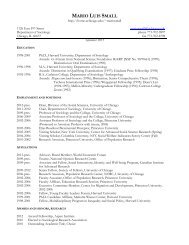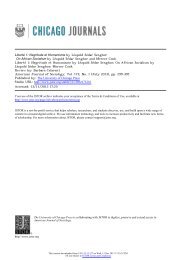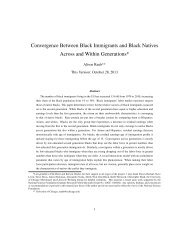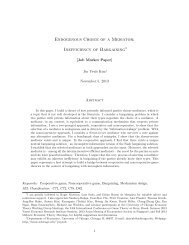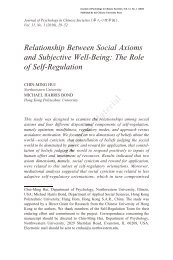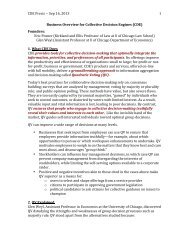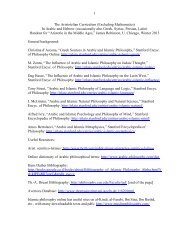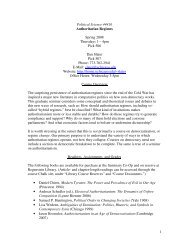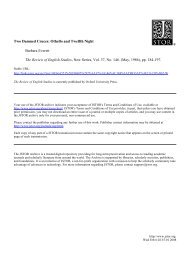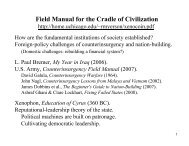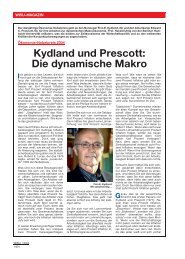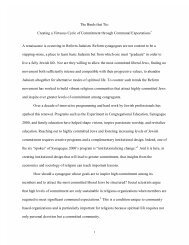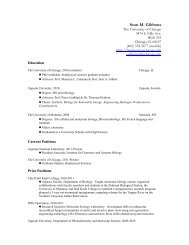Guide to the Study of Early Modern European History For Students ...
Guide to the Study of Early Modern European History For Students ...
Guide to the Study of Early Modern European History For Students ...
Create successful ePaper yourself
Turn your PDF publications into a flip-book with our unique Google optimized e-Paper software.
It does not really matter all that much how extensive your notes are, nor does it<br />
matter all that much whe<strong>the</strong>r your notes are pencilled in <strong>the</strong> margins <strong>of</strong> books and articles<br />
you own, or written out inside <strong>the</strong> back cover, or on separate sheets <strong>of</strong> paper, or in<br />
notebooks, or in word documents on your computer. What does matter is that you have<br />
made <strong>the</strong>m, that you have actively participated in your reading. It is not enough <strong>to</strong> highlight or<br />
underline important passages. Underlining is like xeroxing: you know that <strong>the</strong> text is<br />
important, because o<strong>the</strong>rwise you would not have xeroxed it. But you do not know why it is<br />
important, because you don't know what it says. Taking notes forces you <strong>to</strong> understand what<br />
you read and <strong>to</strong> decide what is important. Copying <strong>the</strong> most important passages verbatim<br />
can be useful (especially if you want <strong>to</strong> refer <strong>to</strong> <strong>the</strong>m in footnotes in your future work). But<br />
<strong>the</strong> best notes do not repeat what you read; <strong>the</strong>y state in your own words what you think about<br />
what you read.<br />
Whatever else you do, make sure that your notes distinguish precisely and consistently<br />
between verbatim quotations (I use quotation marks for verbatim quotations, and only for<br />
verbatim quotations), paraphrases <strong>of</strong> what you have read (no quotation marks, ever), and<br />
your own random observations or ideas about <strong>the</strong> material you're reading [I put those in<br />
square brackets]. If you don't make <strong>the</strong>se distinctions clearly and consistently, you will<br />
sooner or later confuse a verbatim quotation from somebody else's book with your own<br />
ideas. Soon after that you will be charged with plagiarism. Or else you will confuse your own<br />
ideas with something you found in primary sources. Soon after that you will be charged with<br />
fabricating evidence.<br />
I like <strong>to</strong> take notes in longhand and keep <strong>the</strong>m in <strong>the</strong> chronological order in which I<br />
have written <strong>the</strong>m. I find that doing it that way lodges <strong>the</strong> content <strong>of</strong> my notes most firmly<br />
in my mind and makes it easy <strong>to</strong> track down <strong>the</strong> notes I <strong>to</strong>ok when I need <strong>to</strong>. If your<br />
memory works like mine, that will work for you as well. Your memory may <strong>of</strong> course work<br />
quite differently. Many students prefer <strong>to</strong> type notes on <strong>the</strong> computer, because you can<br />
search <strong>the</strong>m and reorganize <strong>the</strong>m without relying on your memory. You can also type faster<br />
than you can write by hand (without a lot <strong>of</strong> practice). In my experience, you never<br />
remember such notes as well as those which you wrote by hand, and you tend <strong>to</strong> change<br />
<strong>the</strong>m or move <strong>the</strong>m around in ways that makes it very difficult <strong>to</strong> find <strong>the</strong>m—unless you<br />
make duplicates, in which case you can't keep track <strong>of</strong> <strong>the</strong> differences between <strong>the</strong> original<br />
and <strong>the</strong> duplicate. After many years <strong>of</strong> experimenting, I have returned <strong>to</strong> <strong>the</strong> simplest<br />
method <strong>of</strong> all: 150-page spiral notebooks, with notes, observations, and drafts in <strong>the</strong><br />
chronological order in which <strong>the</strong>y were written, identified by type and date <strong>of</strong> writing, with a<br />
little index on <strong>the</strong> last page <strong>of</strong> <strong>the</strong> notebook <strong>to</strong> indicate what's <strong>to</strong> be found on which pages.<br />
Third, keep a bibliography. You no longer need <strong>to</strong> use three-by-five index cards,<br />
as I did when I started out. You can use database management s<strong>of</strong>tware specifically designed<br />
for <strong>the</strong> purpose <strong>of</strong> maintaining bibliographic records and creating uniformly styled<br />
bibliographic references in notes or bibliographies <strong>to</strong> be appended <strong>to</strong> papers and books. I<br />
use Endnote, but <strong>the</strong>re are o<strong>the</strong>r programs on <strong>the</strong> market. But whatever method you prefer,<br />
do make it a regular habit <strong>to</strong> create a bibliographic entry for every book and article you come<br />
across <strong>of</strong> which you think you might want <strong>to</strong> read it at some time in <strong>the</strong> future, perhaps by<br />
downloading it directly from <strong>the</strong> web.<br />
Chances are that you will never read <strong>the</strong> books and articles that you recorded in your<br />
bibliography. You cannot read everything in which you are interested. And as time goes on<br />
you will discover that <strong>the</strong> more books and articles you do read, <strong>the</strong> more quickly <strong>the</strong> number<br />
<strong>of</strong> books and articles that you would like <strong>to</strong> read but can't increases. But you can keep a<br />
record. You can build up a bibliography <strong>of</strong> items in which you are interested. And you can<br />
12<br />
12



